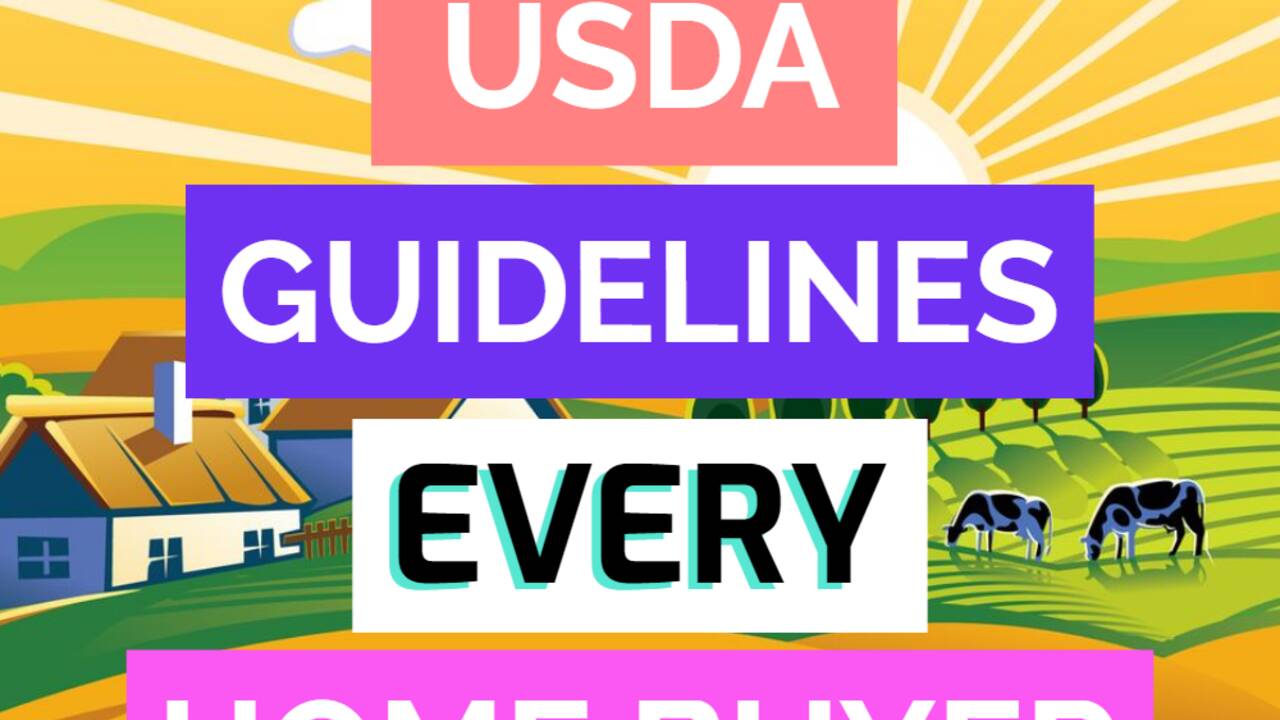Government assistance comes in many forms across the country. One of the lesser-known types of assistance is a mortgage designed for people with average to less-than-average income and with average credit scores. This program is called the USDA Mortgage and it can help a lot of people become homeowners.
Listed below are the top USDA guidelines every home buyer should know before they place an offer on a home for purchase.
Guideline #1: Who is Eligible for the USDA Home Loan
First, to be approved for a USDA loan, the property has to be in a rural area, as defined by USDA. HOWEVER, the term “rural” is a bit misleading. As of this writing, well over 90% of the area across the United States is classified as rural by the USDA. A quick look at the eligibility map on the USDA home site will show you if the home you are considering falls within a rural area.
Secondly, the borrower’s income must be at, or below, a certain level. In general terms, a borrower, or borrower and co-borrower, who have an average income for their immediate area will qualify for the loan.
Guideline #2: Down Payment is Not Required
The most appealing feature of the USDA Home Loan is the chance to finance 100% of the appraised value without the need for a down payment. For people that are making a moderate income, this can save them thousands of dollars compared to other loans that request a 3% to 5% down payment.
It also means that a borrower can buy a home sooner since they do not have to wait months, or years, to save up for a down payment.
Guideline #3: Private Mortgage Insurance is Required on Each USDA Loan
The USDA agency guarantees that an approved loan will be paid. This gives some assurance to lenders to offer the product.
To fulfill that guarantee, USDA needs funds to cover a loan if a homeowner is unable to continue making the payments.
These funds come from existing home loans in the form of private mortgage insurance. The mortgage insurance is charged as an upfront fee on all new loans as well as an annual fee for all loans.
The upfront fee is 1% of the initial loan amount. This fee is added to the loan so that borrowers are not asked to pay the amount upfront.
The annual fee is 0.35% of the outstanding loan balance. The fee is divided by 12 and added to the monthly payments made by homeowners for the USDA loan.
In comparison to other government-backed loans as well as conventional loans, the mortgage insurance rate is much cheaper for USDA Home Loans.
Guideline #4 Basic Loan Repayment with Fixed Interest Rate
USDA loans are only offered with fixed interest rates for the entire term of the loan.
This means there are no adjustable-rate options. It also means the rate will not change for the life of the loan.
It also means that there will not be any type of balloon payment due in a few years nor is there any penalty for paying off the loan early.
Simply stated, each month that the payment is made, an amount of the payment will go towards principal, another amount will go towards interest, and there is also the aforementioned private mortgage insurance fee. Each month, as the loan progresses, the amount going towards principal will increase while the amount going towards interest will decrease.
Guideline #5 Specific Income Limits
As mentioned earlier, the USDA Home Loan is intended for borrowers with moderate income.
The rules for USDA state that the borrower’s total household income may not be more than 15% over the average median income for the borrower’s intended zip code of residence.
For example, if the average income in a certain zip code is $72,000, then the maximum household income for the borrower to be approved for a USDA Home Loan would be $82,800
This is calculated by multiplying 15% by $72,000 which results in $10,800. Then, the $10,800 is added to the $72,000 for a total of $82,800.
Guideline #6 Finding A Lender for USDA Loan
Like most types of mortgages, USDA Home Loans are offered by a variety of mortgage lenders. The USDA agency approves banks, credit unions, and mortgage brokers to offer the loan to qualified borrowers. Lenders will help borrowers complete the loan application and get the necessary documents for a complete loan file.
After the lender has the required paperwork and approves the loan, the file is then sent to the nearest USDA office. That office will review the documents and decide on the loan. This step is unique to USDA mortgage loans.
Guideline #7 Refinancing a USDA Mortgage
If mortgage rates drop, it is possible to refinance an existing USDA Home Loan to a better interest rate.
The process is called a Streamline Refinance. This usually means that a new appraisal is not required and there is less paperwork compared to the purchase process.
One of the main conditions of getting approved for a streamlined refinance USDA mortgage is that the homeowner must be up to date on their mortgage payments and they must have made the last 12 monthly payments on time.
However, USDA does not offer a cash-out refinance option. The only type of refinance allowed is to lower the interest rate or lower the remaining term of the loan.
Guideline #8 Maximum Loan Amount
The rules for USDA Home Loans do not have a maximum loan amount. Instead, the loan is limited by the borrower’s income.
Typically, the borrower cannot have more than 41% of their gross, monthly income dedicated to repaying debt. Debt includes the proposed home loan, any automobile loans, credit cards, student loans, boat or RV loans, or any other monthly payment that is going towards paying off a set amount.
Guideline #9 Type of Borrowers and Type of Property
First time home buyers are welcome to apply for a USDA Home Loan. Repeat home buyers are also eligible to apply.
The USDA Home Loan does limit the type of property that will be approved for the loan. Only a single-family residence is eligible. This means that commercial buildings, duplex, quad-plex, or any other type of multifamily property are not eligible for USDA lending.
This also means that USDA Home Loan cannot be used to purchase a 2nd home, such as a property at the beach or in the mountains. Nor can the loan be used to buy an investment home.
Although the USDA Home Loan is only for properties in defined rural areas, the loan cannot be used to buy a home with a large tract of land. The maximum amount of land that can be purchased, with a home, is 5 acres.
Guideline #10 Property Taxes and Property Insurance
Borrowers are required to use an escrow service to handle property insurance and property taxes.
This means that the yearly amounts for both the property taxes and the insurance will be divided by 12 and added to the monthly payment. Once a year, the escrow service will use those funds to make payment to the local municipality for the property taxes and the designated homeowner’s insurance agent.
Guideline #11 Closing Costs
Closing costs will vary from lender to lender. The most common items that will be required are an appraisal of the property, credit report, title insurance binder on the home being purchased, initial escrow for the homeowner’s insurance and property taxes, and a survey if needed.
Different lenders may have other closing cost items. The specific lender you choose can offer an estimate of the closing items and their prices.
Closing costs may be paid by the borrower, can be paid via a gift, or can come from the seller.
If the costs are being paid as a gift from a relative, there will be specific forms that need to be filled out as well as supporting documentation for the gift.
If the seller agrees to pay the closing costs, it will need to be detailed in the purchase agreement between the buyer and seller of the property.
Guideline #12 Self Employed Borrowers
Self-employed borrowers are welcome to apply for the USDA Home Loan. These borrowers will need to provide 2 years of Federal tax returns for both their business and their personal returns. Less than 2 years will not be approved for the loan.
Summing Up 12 USDA Guidelines Every Home Buyer Should Know
These are the top guidelines that all borrowers need to be aware of when they are applying for a USDA Home Loan.
This loan was established to help people with moderate incomes enjoy homeownership benefits while also strengthening the rural, local communities. By allowing people to buy modest homes without a significant down payment, smaller communities can see stable property owners thrive in their areas and contribute to the greater good.
About the author: This article on “12 USDA Guidelines Every Home Buyer Should Know” was written by Luke Skar of MadisonMortgageGuys.com. As the Social Media Strategist, his role is to provide original content for all of their social media profiles as well as generating new leads from his website.
Providing award-winning customer service to clients who need to purchase a home or refinance an existing mortgage in Alaska, Alabama, Arkansas, Arizona, California, Colorado, Connecticut, District of Columbia, Delaware, Florida, Georgia, Iowa, Idaho, Illinois, Indiana, Kansas, Kentucky, Louisiana, Massachusetts, Maryland, Maine, Michigan, Minnesota, Missouri, Mississippi, Montana, North Carolina, North Dakota, Nebraska, New Hampshire, New Jersey, New Mexico, Nevada, Ohio, Oklahoma, Oregon, Pennsylvania, Rhode Island, South Carolina, South Dakota, Tennessee, Texas, Virginia, Vermont, Washington, Wisconsin, West Virginia, and Wyoming!
If you found this article helpful, please consider sharing it with your social networks. Also, be sure to check us out on diigo!



Comments(0)